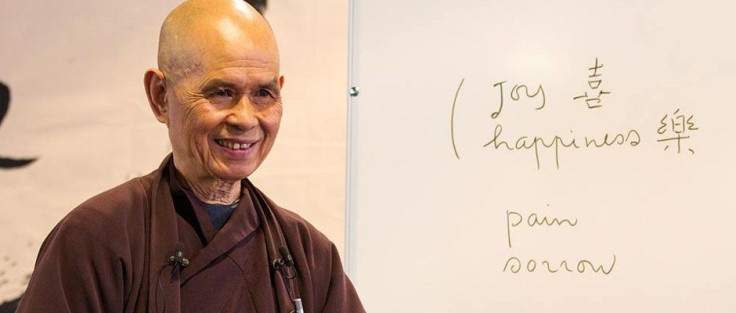Who Is Thich Nhat Hanh? Zen Master Suffers Brain Hemorrhage

Thich Nhat Hanh was hospitalized this week following a brain hemmorhage. The globally reknowned spiritual leader is "very responsive" but still under intensive care, according to a statement made by his followers.
Who is Thich Nhat Hanh?
Thich Nhat Hanh, or Thay, is an 88-year-old Buddhist monk who is considered to be the world’s most influential Buddhist leader, aside from the Dalai Lama. He is a Zen master, teacher, poet, author and peace activist. He was born in Vietnam in 1926 and was ordained as a novice monk at age 16. Thay is largely credited for bringing Buddhism to the West, according to the BBC.
What are his teachings?
“Through mindfulness, we can learn to live happily in the present moment -- the only way to truly develop peace, both in one’s self and in the world,” according to Thay’s website. He has written over 100 publications on meditation, mindfulness and Engaged Buddhism -- a movement he coined during the Vietnam War, in which Buddhists actively apply their meditation and mindfulness practice to situations of social, political, economic and environmental suffering. The Dalai Lama wrote the foreword to Thay’s book “Peace is Every Step,” in which he wrote “[Thay] shows us how to use the benefits of mindfulness and concentration to transform and heal difficult psychological states. He shows us the connection between personal, inner peace and peace on Earth.”
How did he rise to prominence?
After a few years of studying and teaching Buddhism at Princeton and Columbia universities in the United States, Thay returned to Vietnam to pioneer the Buddhist peace effort in the mid-1960s, when the Viet Cong insurgency had intensified and the war grew to full scale. In 1966, Thay left Vietnam for the West once again, but this time to call for peace and an end to the Vietnam War. On his trip in the United States, he met and befriended Dr. Martin Luther King Jr., who nominated him for the Nobel Peace Prize in 1967, writing: “I do not personally know of anyone more worthy of the Nobel Peace Prize than this gentle Buddhist monk from Vietnam,” King wrote in a letter to the Nobel Institute dated Jan. 25, 1967. “Here is an apostle of peace and non-violence, cruelly separated from his own people while they are oppressed by a vicious war which has grown to threaten the sanity and security of the entire world,” King wrote, referring to the fact that Thay was barred from returning to Vietnam by both the non-Communist and Communist. He has been living in exile for the last 39 years. Thay continued his teachings and eventually founded Plum Village near Paris, the largest and most active Buddhist monastery in the West. Nearly 8,000 people visit Plum Village each year. Today, Thay has established six monasteries, dozens of mindfulness practice centers in Europe and the United States and over a thousand local practice communities, according to the Plum Village website.
Where is he now?
Thay was hospitalized after suffering a severe brain hemorrhage on Tuesday, Nov. 11, in France. He is currently receiving 24-hour intensive care, according to a press release from Plum Village’s Monastic Dharma Teacher Council. “Thay is still very responsive and shows every indication of being aware of the presence of those around him,” the council stated. “There are signs that a full recovery may be possible.” Thay had previously been hospitalized in Bordeaux on Nov. 1.
© Copyright IBTimes 2024. All rights reserved.





















